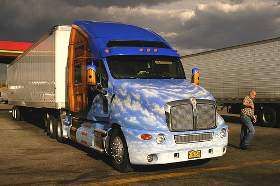Review Questions - Click On The Picture To Begin...

- If you have a sliding fifth wheel, you must make sure the fifth wheel is securely locked in place
- Be sure the landing gear is fully raised, no missing parts, not bent or otherwise damaged
- Check the the air lines and electrical line to be certain they are properly secured and connected
- Make sure the fifth wheel locking jaws are around the head of the kingpin and not the shank of the kingpin
Quote From The CDL Manual:
Inspecting a Combination Vehicle
- Locking jaws around the shank, not the head of kingpin.
- Landing gear is fully raised, no missing parts, not bent or otherwise damaged.
- Air lines properly connected to glad hands, no air leaks, properly secured with enough slack for turns.
- All sliding fifth wheel locking pins present and locked in place
- While stopped, pull out the yellow parking brake control and pull gently on the trailer with the tractor
- While idling in the lowest gear possible, pull out the trailer air supply control to see if you come to a safe stop
- While idling in the lowest gear possible, pull out the yellow parking brake control to see if you come to a safe stop
- While stopped, pull out the trailer air supply control and pull gently on the trailer with the tractor
Quote From The CDL Manual:
Test trailer emergency brakes: Charge the trailer air brake system and check that the trailer rolls freely. Then stop and pull out the trailer air supply control (also called "tractor protection valve control" or "trailer emergency valve") or place it in the "emergency" position. Pull gently on the trailer with the tractor to check that the trailer emergency brakes are on.
- With the engine on, step on and off the brake pedal several times until the trailer air supply control pops out
- With the engine on, engage and release the parking brake several times until the trailer air supply control pops out
- With the engine off, step on and off the brake pedal several times until the trailer air supply control pops out
- With the engine off, engage and release the parking brake several times until the trailer air supply control pops out
Quote From The CDL Manual:
Test tractor protection valve: Charge the trailer air brake system. (i.e., build up normal air pressure and push the "air supply" knob in.) Shut off the engine. Step on and off the brake pedal several times to reduce the air pressure in the tanks. The trailer air supply control (also called the tractor protection valve control) should pop out or go from "normal" to "emergency" position) when the air pressure falls into the pressure range specified by the manufacturer (usually within the range of 20 to 45 psi).
- With the engine off, step on and off the brake pedal several times to reduce the air pressure in the tanks and make sure the tractor protection valve pops out
- Release all brakes except the trailer service brakes using the trailer hand control valve (trolley valve) then walk back to the rear of the trailer and visually check to be sure the brakes are engaged
- Check for normal air pressure, release the parking brakes, move the vehicle forward slowly, and apply trailer brakes with the hand control (trolley valve), if so equipped
- Pull out the trailer air supply control and pull gently on the trailer with the tractor to make sure the brakes work
Quote From The CDL Manual:
The trailer service brakes: Check for normal air pressure, release the parking brakes, move the vehicle forward slowly, and apply trailer brakes with the hand control (trolley valve), if so equipped. You should feel the brakes come on. This tells you the trailer brakes are connected and working. (The trailer brakes should be tested with the hand valve but controlled in normal operation with the foot pedal, which applies air to the service brakes at all wheels.)
TruckingTruth's Advice:
Many companies are no longer installing trailer hand control valves which is very unfortunate as this is really the only way to be certain the trailer service brakes are functioning properly. If your truck does not come equipped with a trailer hand control valve, test your brakes before you start driving on a major roadway. If you notice the truck struggling to stop, the problem most likely is with your trailer brakes and needs to be inspected.
- Between 20 and 45 psi
- Between 100 and 120 psi
- Between 5 and 15 psi
- Between 50 and 75 psi
Quote From The CDL Manual:
The trailer air supply control (also called the tractor protection valve control) should pop out or go from "normal" to "emergency" position) when the air pressure falls into the pressure range specified by the manufacturer (usually within the range of 20 to 45 psi).








 TT On Facebook
TT On Facebook